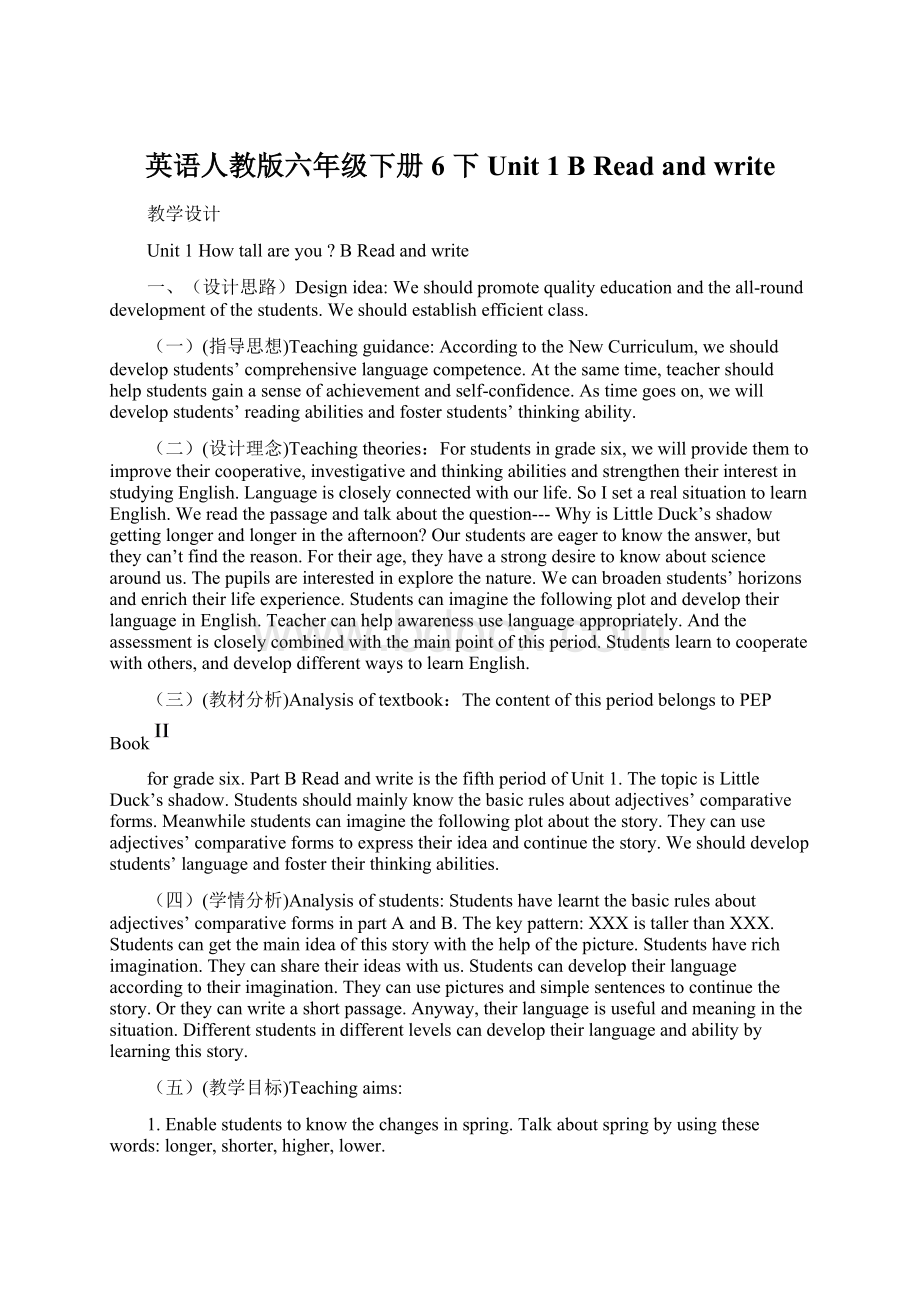英语人教版六年级下册6 下 Unit 1 B Read and writeWord格式.docx
《英语人教版六年级下册6 下 Unit 1 B Read and writeWord格式.docx》由会员分享,可在线阅读,更多相关《英语人教版六年级下册6 下 Unit 1 B Read and writeWord格式.docx(7页珍藏版)》请在冰豆网上搜索。

1.Enablestudentstoknowthechangesinspring.Talkaboutspringbyusingthesewords:
longer,shorter,higher,lower.
2.Enablestudentstoreadthestoryandgetthemainidea,atthesametime,theycanguessthemeaningofthenewwordsinthecontext.StudentscanfinishtheexercisesandgetacertainabilityoflearningEnglish,especiallyimprovetheirwritingability.
3.Trytounderstandthestoryandusethekeywordsandphrases:
lowerandlower,longerandlonger,smarter,older,taller.StudentscantalkaboutLittleDuck’squestion:
“Whyismyshadowlongerwhenthesungetslower?
”andtrytofindtheanswer.
4.Understandthemeaningoftheword:
shadowwiththehelpofZhangYuxin’sshadowIcollecteddaysbefore.Wecanfindthephenomenoninthereallife.StudentscangettheanswerbywatchingZhangYuxin’sdifferentshadowscarefully.
5.Trytochangethestoryintoadialogue,thenitactoutinpairs.
6.Enablestudentstoimaginethefollowingplotandcontinuethestory.Meanwhileteachertriestohelpstudentsdeveloptheirwritingabilityafterreading.
(六)(教学重点)
Keypoints:
Thekeypatterns:
WhyisLittleDuck’sshadowlongerwhen
thesungetslower?
Differentpoints:
Studentscangetthemeaningoftheword:
shadow.
二、(教学准备)Teachingpreparations:
(教具准备):
PPT,photosofZhangYuxin’sshadow,torch,headdressersofLittleDuckandOldTree,picturesofLittleDuckandOldTree.
(学具准备):
Head-dressersofZhangWuYifanandRobin.
三、
(教学过程)Teachingsteps:
BReadandwrite
Step1:
Warm-up
1.Greetingsandsingasong---Fourseasons.
T:
What’syourfavoriteseason?
Ss:
Spring.
Why?
BecauseIcangoonapicnic.
Metoo.Becausetherearebeautifulflowersinthetree.
(设计意图:
歌曲---四季,节奏轻快活泼,歌词简单易懂,容易将学生的注意力吸引到英语课堂上,询问学生喜欢的季节及原因,与学生进行亲切的交流,开门见山,引出与本节课相关的话题---春天。
)
2.Talkaboutthechangesbetweenspringandwinter.
Whatafinedaytoday!
Springiscoming.Whatdifferencescanyoufind?
Shareusyouridea.
It’sgettingwarmerandwarmer.Thedayisgettinglongerandlonger.Thenightisgettingshorterandshorter.
Great.Theskyisclearer.Thesunisbrighter.Igetupearlier.
教师通过谈话,让学生发现春天的变化。
此话题贴近学生的生活,看到学校校园的玉兰树开花的图片,感知并运用本单元所学习的形容词比较级,谈论天气、树木、白天和晚上时间长短的变化,活跃学生思维。
Step2.Presentation
1.Pre-reading
(1)Introducethecontentofthepage8.Lookandticktherightpictures.
Talkaboutthepictures,andtellusthemeaningofthepicture.
Winter,spring,cold,warm.
学生通过读图,选出符合春天的图片。
(2)Changesinspring.
Showthepictureofspringinourschool.
Theskyisclearer.Theweatheriswarm.Thereareflowersinthetree.Thedayisgettinglonger.Thenightisgettingshorter.
Perfect.Andthesunisbrighter.wearefeelingbetterinspring.Thehazydaysarebecominglessandless.
教师用PPT呈现一幅春天的校园图片,给出关键词,让学生从天空、天气、白天和晚上四个方面谈论,使用比较级句型进行描述春天的变化。
教师在此用春天来了,阳光明媚,人们心情也好多了,雾霾的日子越来越少了,教育学生保护环境的重要性。
2.While-reading
(1)Readthepassageandtrytounderstandit.
●Thefirstreading.
Question:
Whoisinthestory?
LittleDuckandOldTree.
学生自主阅读短文,并根据自己所需要了解的信息快速浏览,获取关键信息。
●Thesecondreading.
Readthepassageagain,andchooseatitleforthispassage,thenwritethetitle.
Circlethenewwordsyoudon’tknow,andtrytoguesstheirmeaningaccordingtothecontext.Thinkaboutthequestions:
WhatisLittleDuckdoing?
Whendoesthestoryhappen?
在第二次阅读时,圈出自己不懂的词或短语,并根据需要,寻找细节信息,放慢阅读速度,在找到的关键信息处划线或做标志。
●Thethirdreading.
(1)Listenandrepeat.
Readthepassageandlistentothetape,children.
Followthetape,andtrytoimitatethepronunciation,tune,andintonation.
Guidestudentstofillintheblanks,andfinishthedialogue.Thenfindthekeywordsandretellthestory.
(2)Roleplay.
Usethekeywords:
lowerandlower,longerandlonger,olderandsmarter,longer,lower,older,longer,taller.
Actoutthestoryinroles.
在第三次阅读文本时,先听音模仿,对自己不会读的词汇不懂的词进行重点识记。
完成相关练习,补全对话。
当我们复述短文时,先整理出关键词,再根据关键词进行复述。
3、After-reading
(1)Talkaboutthequestionswithyourpartner:
Questions:
DoyouagreewiththeOldTree?
(2)Discussthequestionsinyourgroup.
CanyouanswerLittleDuck’squestion?
What’syouranswer?
(3)UsePPTtoshowthereason.
Lookattheseshadowscarefully.Whatcanyoufind?
Theshadowisgettinglongerandlonger.Becausethesunisgettinglowerandlower.Thelightgoesdirectly,andtheangleoftheelevationofthesunischanging.
Youcangettheanswerfromthepicture.
阅读后,教师可以根据鸭子遇到的疑惑,培养学生的发散思维,让学生动脑思考。
在通过PPT呈现张瑜馨同学的影子变化图,让学生直观地感知影子变化规律。
接着,通过一张图来解释影子的变化与太阳的高度有关,角度在不断变化,再加上太阳光线在空气中(或同一种物质中)是直线传播的,再讲解一些生活中的折射现象,开拓学生的知识视野,培养他们探究科学的意识和兴趣。
(4)Circlethewordswith-er,andfindtherules.
Canyoufindtherulesaccordingtotheadjectives’comparativeforms?
S1:
Add–erdirectly.
S2:
Doublethelastletterandadd–er..
S3:
Changethelastletter–yinto–i,thenadd–er.
Great.Andthereisanotherform.Thatis:
addmorebeforethewordswithmoresyllables,suchas:
interesting,beautiful,wonderful.
学生圈出文中带有-er的单词,总结规律,养成良好的学习习惯。
Step3.Practiceandextension
(1)T:
Listenandreadthetextagain.
Readthepassagewithyourpartners.
Readthepassagefluently.
(2)Roleplay
Who’dliketoactoutthestory?
S1&
S2:
I’dliketohaveatry.FirstIwearmyhair-dresser.
(3)Continuethestory.
Canyoucontinuethestory?
OrtrytocontinuethedialoguebetweenLittleDuckandOldTree.
Extendthestoryaccordingtotheirthought.
学生通过再次听音模仿,学习准确的语音和语调,为角色表演做好铺垫。
通过角色表演,学生能够强化对文本的印象。
《英语课程标准》提出要“倡导学生体验参与”,“重视通过做事学习知识。
”学生可以发挥自己丰富而独特的想象力进行续编故事,将思维的培养和语言的发展在语境中有机的结合起来,达到了学以致用的教学效果。
Step4.Summary
Today,we’velearntsomereadingskillsduringthreeperiods:
pre-reading,while-reading,after-reading,andknowthemainideaofthepassage.Studentscandeveloptheirabilitywhilereading.
(设计意图:
在结束本节课时,用本单元的谚语:
少即是多。
(Lessismore.),鼓励学生要努力学习,积极思考,积少成多,举一反三,能够做到触类旁通,养成良好的学习习惯和行为习惯。
Step5:
Homework:
Continuethestory.
Youcandrawpicturesorwriteapassage.It’suptoyou.Oryoureadthestoryfluentlyaspossibleasyoucan.
学生可以根据自己的能力选择作业的形式,这里也体现了分层次布置作业的特点,学生可以根据自己的能力,完成相关作业,可以调动学生学习的积极性和主动性。
(板书设计)Boarddesign:
Unit1Howtallareyou?
LittleDuck:
Whyismyshadowgettinglonger?
OldTree:
That’seasy.Becausethesungoesdowneveryday,
andyougrowoldereveryday.Yourshadowgrows
longerbecauseyou’regrowingtaller.
LittleTree:
Isthattrue?
Whatwillhappentome?
Well,…
Difficultwords:
lowerandlower,shadow,smarter,grows
四、(教学反思)Feedback:
(思得、思失、思效、思改)
思得:
本节课学生在创设的语境中,运用本单元所学的形容词比较级形式,谈论春天以及春天的变化,让学生积极思考,发现冬天和春天的不同,切入话题,引出故事。
一个主线---鸭子的影子变化,两条思路---鸭子的疑虑和老树的回答。
阅读前,教师通过谈话,发现春天的变化,激活已知。
阅读中,学生通过三次阅读,接触文本,根据需要,获取相关信息,逐步深入的理解文章,并在读中掌握阅读技巧。
正如《英语课程标准》提出的那样:
“倡导学生体验参与”,“重视通过做事学习知识。
”阅读后,学生能够完成相关练习,体验阅读的快乐,并运用自己丰富的想象力续编故事,进一步发展语言,提高语言的表达能力,将思维的培养和语言的发展在语境中有机的结合起来,体现了语言学习的工具性。
同时,学生不同思维方向,既让故事得到延伸和拓展,又赋予了小鸭子和老树童话般的语言色彩,让我们走进故事,走进儿童的心灵深处,体现了语言学习的人文性。
思失:
首先,本节课由于课堂时间所限,在故事复述和表演环节处理得比较仓促,学生参与较少。
其次,评价手段较为单一,过程性评价仅限于肢体动作和语言,没有创造性的评价方式。
最后,在课堂结束时,没对板书及本节课进行总结,教学是一门遗憾的艺术,给我留下了进一步改进和提升的空间,让我在教